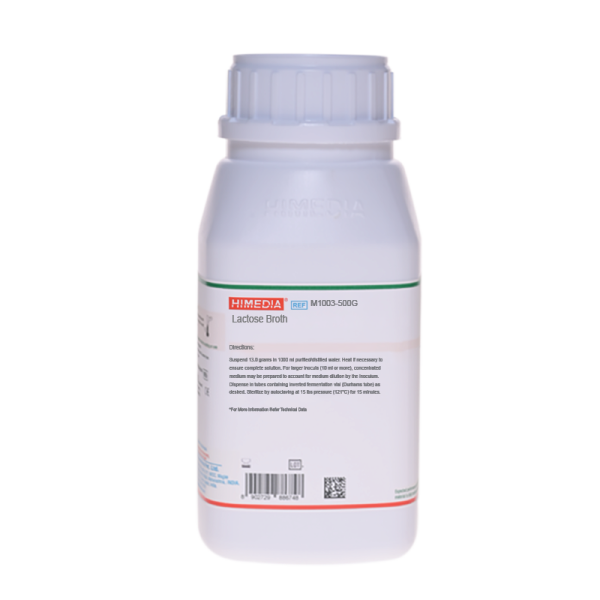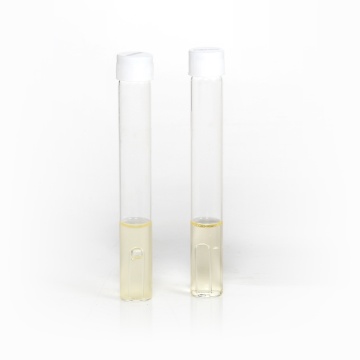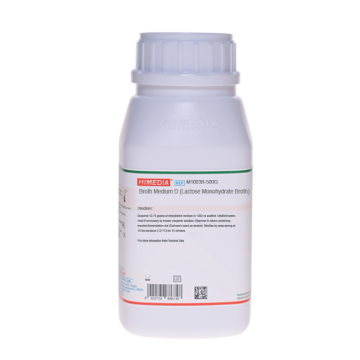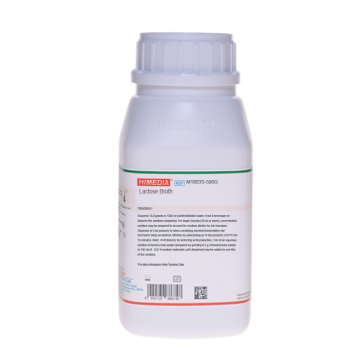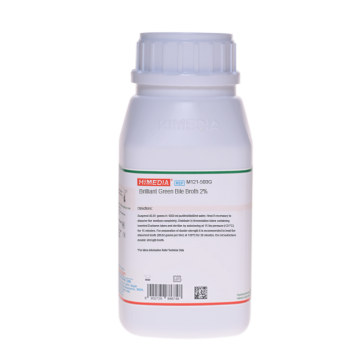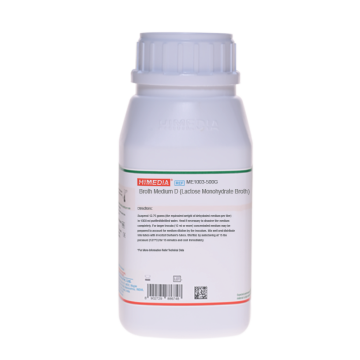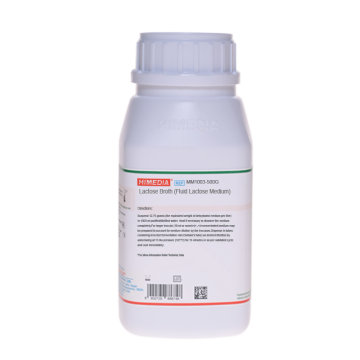 Your enquiry has been submitted
Your enquiry has been submitted
Lactose Broth
Pre Enrichment#CC293D
Intended use
Recommended for the detection of Enterobacteriaceae particularly coliform and Salmonella species from water, food and dairy products as per Standard Methods and FDA BAM.
Composition**
| Ingredients | g/L |
|---|---|
| Peptone | 5.000 |
| HM Peptone B# | 3.000 |
| Lactose | 5.000 |
Final pH (at 25°C): 6.9±0.2
**Formula adjusted, standardized to suit performance parameters
# - Equivalent to Beef extract
Directions
Suspend 13.0 grams in 1000 ml purified/ distilled water. Heat if necessary to dissolve the medium completely. For larger inocula (10 ml or more), concentrated medium may be prepared to account for medium dilution by the inoculum. Dispense in tubes containing inverted fermentation vial (Durham's tube) as desired. Sterilize by autoclaving at 15 lbs pressure (121°C) for 15 minutes.
Principle And Interpretation
Examination of water, foods, ingredients and raw materials, for the presence of marker groups such as coliforms is one of the most common tests in a microbiology laboratory, partly because of the relative ease and speed with which these tests can be accomplished. Where it is claimed that drinking water has been processed for safety, the finding of such organism demonstrates a failure of the process. It is a valuable bacterial indicator for determining the extent of fecal contamination of recreational surface waters or drinking water (1).
Lactose Broth is recommended by APHA in the performance and confirmation of the presumptive test for coliform bacteria in water (1), food (2) and milk (3). This medium was initially listed as an alternative to Lauryl Sulfate Broth in the presumptive Standard Total Coliform Multiple-Tube (MPN) Test for water analysis. Although it is not the original formulation, Lactose Broth provides excellent results in Eijkman Assays of gas production at 45°C, which is a characteristic of Escherichia coli. While preparing this medium it is important to avoid overheating and to distribute it into tubes before sterilization. This medium is recommended by FDA BAM for presumptive identification of coliforms, E.coli and faecal coliforms using MPN Technique (4).
Peptone and HM Peptone B in the medium supply nitrogenous and carbonaceous compounds, long chain amino acids and other essential nutrients to the organisms. Lactose is a fermentable carbohydrate for the coliforms. Tubes of Lactose Broth are inoculated with dilutions of water or milk, etc. under test, and incubated at 35°C and examined for gas formation after 24 and 48 hours. Members of the coliform group are defined as aerobic and facultative anaerobic gram-negative and non-sporing bacilli, which ferment lactose with gas formation within 48 hours at 35°C. In testing dairy products, Lactose Broth is used only in the completed test (4). Large water samples may require double strength Lactose Broth to minimize the final volume.
Type of specimen
Food and dairy samples; Water samples
Specimen Collection and Handling:
For food and dairy samples, follow appropriate techniques for sample collection and processing as per guidelines (2,3,4). For water samples, follow appropriate techniques for sample collection, processing as per guidelines and local standards(1). After use, contaminated materials must be sterilized by autoclaving before discarding.
Warning and Precautions :
Read the label before opening the container. Wear protective gloves/protective clothing/eye protection/ face protection. Follow good microbiological lab practices while handling specimens and culture. Standard precautions as per established guidelines should be followed while handling specimens. Safety guidelines may be referred in individual safety data sheets
Limitations :
- Further isolation and biochemical tests must be carried out for confirmation.
Performance and Evaluation
Performance of the medium is expected when used as per the direction on the label within the expiry period when stored at recommended temperature.
Quality Control
Appearance Cream to yellow homogeneous free flowing powder
Colour and Clarity of prepared medium Light to medium amber coloured clear solution without any precipitate
Reaction Reaction of 1.3% w/v aqueous solution at 25°C. pH: 6.9±0.2
pH 6.70-7.10
Cultural Response
Cultural characteristics observed after an incubation at 35-37°C for 18-48 hours.
| Organism | Inoculum (CFU) | Growth | Gas |
|---|---|---|---|
| # Klebsiella aerogenes ATCC 13048 (00175*) | 50-100 | luxuriant | positive reaction |
| Enterococcus faecalis ATCC 29212 (00087*) | 50-100 | luxuriant | negative reaction |
| Escherichia coli ATCC 25922 (00013*) | 50-100 | luxuriant | positive reaction |
| Pseudomonas aeruginosa ATCC 27853 (00025*) | 50-100 | luxuriant | negative reaction |
| ^Pseudomonas paraeruginosa ATCC 9027 (00026*) | 50-100 | luxuriant | negative reaction |
| Escherichia coli ATCC 8739 (00012*) | 50-100 | luxuriant | positive reaction |
Key: * Corresponding WDCM numbers # Formerly known as Enterobacter aerogenes ^ Formerly known as Pseudomonas aeruginosa
Storage and Shelf Life
Store between 10-30°C in a tightly closed container and the prepared medium at 15-30°C. Use before expiry date on the label. On opening, product should be properly stored dry, after tightly capping the bottle inorder to prevent lump formation due to the hygroscopic nature of the product. Improper storage of the product may lead to lump formation. Store in dry ventilated area protected from extremes of temperature and sources of ignition Seal the container tightly after use. Product performance is best if used within stated expiry period.
Disposal
User must ensure safe disposal by autoclaving and/or incineration of used or unusable preparations of this product. Follow established laboratory procedures in disposing of infectious materials and material that comes into contact with sample must be decontaminated and disposed of in accordance with current laboratory techniques (5,6).
Reference
- Lipps WC, Braun-Howland EB, Baxter TE,eds. Standard methods for the Examination of Water and Wastewater, 24th ed. Washington DC:APHA Press; 2023.
- Salfinger Y., and Tortorello M.L., 2015, Compendium of Methods for the Microbiological Examination of Foods, 5th Ed., American Public Health Association, Washington, D.C.
- Wehr H. M. and Frank J. H., 2004, Standard Methods for the Microbiological Examination of Dairy Products, 17th Ed., APHA Inc., Washington, D.C.
- Peter Feng, Stephen D. Weagant, Michael A. Grant, William Burkhard, FDA BAM Chapter 4: Enumeration of Escherichia coli and the Coliform Bacteria.
- Isenberg, H.D. Clinical Microbiology Procedures Handbook. 2nd Edition.
- Jorgensen, J.H., Pfaller, M.A., Carroll, K.C., Funke, G., Landry, M.L., Richter, S.S and Warnock., D.W. (2015) Manual of Clinical Microbiology, 11th Edition. Vol. 1.
| Product Name | Lactose Broth |
|---|---|
| SKU | M1003 |
| Product Type | Regular |
| Physical Form | Powder |
| Origin | Animal |
| Packaging type | HDPE |
| References | 1. Corry J. E. L., Curtis G. D. W., and Baird R. M., Culture Media for Food Microbiology, Vol. 34, Progress in IndustrialMicrobiology, 1995, Elsevier, Amsterdam |
| Customized Product Available | No |



